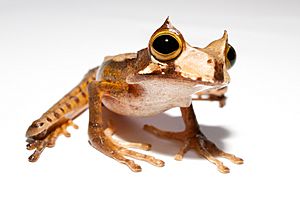Horned marsupial frog facts for kids
Quick facts for kids Horned marsupial frog |
|
|---|---|
 |
|
| Conservation status | |
| Scientific classification | |
| Synonyms | |
|
Hyla ceratophrys Stejneger, 1911 |
The horned marsupial frog (Gastrotheca cornuta) is a very special type of frog. It was first described by George Albert Boulenger in 1898. These frogs live in trees in countries like Colombia, Costa Rica, Ecuador, and Panama. They prefer warm, wet forests, including misty cloud forests high up in the mountains. Sadly, their homes are disappearing, which puts them in danger.
Contents
What Does It Look Like?
An adult horned marsupial frog usually grows to be about 7 to 8 centimeters long. That's about the length of a credit card! Its head is wide, and its snout (nose area) looks rounded when you see it from above. The frog's eyes have a bronze-colored circle around the pupil, with a greenish center. A cool feature is the triangular peak on its upper eyelid, which looks a bit like a horn – that's where it gets its name!
The skin on its back is smooth and has several small bumps or ridges across it. Its fingers don't have webs, but they have round pads on the tips, which help it grip branches. Its back legs are long, and its toes have some webbing between them.
One of the most amazing things about this frog is how the female carries her babies. She has a special pouch on her lower back where she keeps her eggs safe!
At night, the frog's body is a pale brown color. But during the day, it turns dark brown. It also has light markings between its mouth and eyes during the day. This frog also has thin, dark stripes across its body. A dark line runs from near its eye all the way to its groin. Its belly is usually pinkish or light brown.
Where Does It Live?
The horned marsupial frog is a nocturnal animal, meaning it is active at night. It lives in tropical forests and lower mountain cloud forests. You can find it in the Limón Province of Costa Rica, and in nearby areas of Panama. In these places, it lives on the Atlantic side of the mountains, at heights between 300 and 700 meters above sea level.
In Colombia, Ecuador, and Panama, it lives on the Pacific side of the mountains. Here, it can be found at heights between 90 and 1000 meters above sea level. This frog likes to live high up in the forest canopy, which is the top layer of trees.
Life Cycle and Reproduction
The male horned marsupial frog calls from high in the tree canopy to find a mate. His call sounds a bit like a champagne cork popping!
The eggs of the horned marsupial frog are the largest known eggs of any amphibian. The female carries these large eggs in her special pouch, with each egg in its own little space. As the baby frogs grow inside the eggs, they have umbrella-like gills on the outside. These gills spread out against the wall of the mother's pouch. The pouch wall has many tiny blood vessels, which allows the babies to get oxygen from their mother.
What's really interesting is that these frogs do not have a free-living tadpole stage. This means they don't hatch as tadpoles that swim in water. Instead, they develop fully inside the mother's pouch. When they are completely developed, tiny froglets crawl out of the brood pouch, looking like miniature versions of the adult frogs!
Why Is It Endangered?
The horned marsupial frog is listed as "Endangered" on the IUCN Red List of Threatened Species. This means its numbers are decreasing, and it is at high risk of disappearing forever.
Its population has been shrinking across its range. It is no longer found in some parts of Costa Rica and Panama on the Atlantic side. Its numbers have also gone down in Colombia and Ecuador, where it was never very common to begin with. We don't know much about its status in eastern Panama.
There are several reasons why this frog is in trouble. One big reason is habitat loss, which means the forests where they live are being destroyed. Another threat is a disease called chytridiomycosis, which affects amphibians worldwide. Human activities also play a part in its decline.
See also
 In Spanish: Gastrotheca cornuta para niños
In Spanish: Gastrotheca cornuta para niños


